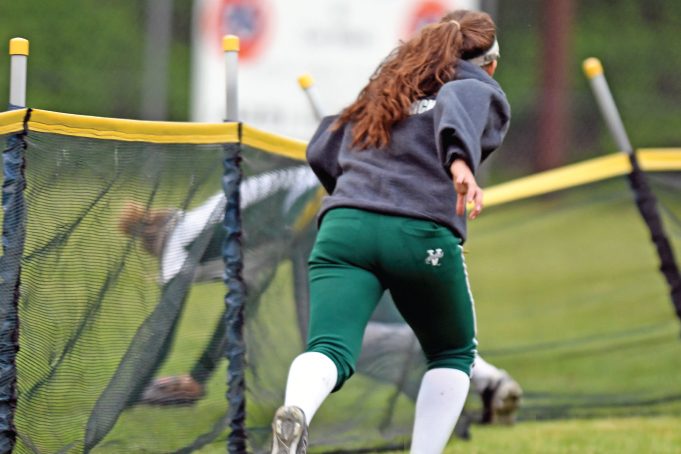More than half of the time while working the bases in fast pitch, you’ll be setting up in position A down the right-field foul line. When the ball is batted to the outfield with no runners on base, you’ll have to make critical decisions from your position just off the line in foul territory 18 to 21 feet behind first base about how you’re going to cover the play.
Will you “go out” on a fly ball? Will you make a pivot? You should if the ball falls in for a hit. Or will you do something else? On every batted ball, the base umpire must use the “pause, read and react” technique to consider his or her actions.
Simply, that means the base umpire must make a decision about the developing play and determine where to go in order to provide the best possible coverage.
Going out. In a crew of two, if the base umpire decides to go out or “chase” to rule on fly balls, the plate umpire enters the infield and takes the batter-runner around the bases as far as she goes. That means the base umpire has to make an important decision: Is it necessary to go out?
If the base umpire decides to go out, he or she must communicate that to the plate umpire. It isn’t enough to let the other umpire see the base umpire’s back as he or she sprints to the outfield. As an example, the NFHS manual suggests a phrase such as, “One umpire,” or “Going.”
It seems there is a “rabbit” in every local association. He or she is a frustrated outfielder who loves to chase every batted ball to its destination. The rabbit is so out of control that he or she has crashed into outfielders and fallen down while chasing balls and attempting to return to the infield. Frequently the result is winding up in unfavorable field positions.
An umpire who goes out on a ball must never interfere with play. Once the umpire goes out, he or she should never return to the infield to “help” on the play. Umpires should also strive to keep the field in good officiating balance.
Inexperienced or overzealous umpires sometimes charge into left field from position A. That method is unacceptable. The base umpire should only go out on trouble balls that are batted from directly to the center fielder to the fence or dead-ball line in right field.
Trouble balls include a diving attempt by a fielder, a difficult try near a fence, foul line or dead-ball line, and areas where a ball may go over, under or through a field fence.
Once the center fielder moves to her right, the plate umpire takes responsibility for the ball and the base umpire makes a standard pivot and takes the batter-runner as far as third base. That keeps the field in balance.
Every year at least one new umpire asks, “Once I go to the outfield, should I ever return to the infield to help on a play in the infield?” The answer is no, but with association approval there is a unique play in which the base umpire can help, as long as it has been discussed at the association level as an approved mechanic.
When a ball is hit over the right fielder’s head U1, who has already gone out, can consider returning to the infield once he or she is certain that the ball is going to remain in live-ball territory on a field that is completely enclosed. If U1 attempts to return to the infield, it should only be for a potential play at the plate. If that mechanic is approved locally, U1 should move toward home plate in foul ground. U1 should only attempt to come home if he or she is able to clearly be in position for a play ahead of the runner. If U1 cannot get to the plate in time to be set for a play, it is better to stay away from that area and let the plate umpire handle the entire play.
If the base umpire intends to take the play at the plate, he or she should verbalize, “I’ve got the plate,” to avoid an umpire traffic jam at the plate. Stressing again, that mechanic should only be used with association approval.
The pivot. When the base umpire reads that his or her presence is not required or needed in the outfield on a batted ball, U1 will enter the infield and make a pirouette to the left at the pivot point that’s about 10 feet from the first-base foul line and 10 feet inside the baseline between first and second bases. U1 takes responsibility for the batter-runner in the “umpire’s run” about 10 feet inside and adjacent to the baselines all the way to third base as the plate umpire watches the ball.
The important thing to remember in all umpiring systems is umpires must know where they need to be on any given play. Where an umpire needs to be for a play may not be the best choice of positioning for that particular play because of potential continuing action.
Only when you know where you need to be, not only for the immediate play, but any potential subsequent plays, can you make the best decision on going out — working the rim or doing a traditional pivot.
What's Your Call? Leave a Comment:
Note: This article is archival in nature. Rules, interpretations, mechanics, philosophies and other information may or may not be correct for the current year.
This article is the copyright of ©Referee Enterprises, Inc., and may not be republished in whole or in part online, in print or in any capacity without expressed written permission from Referee. The article is made available for educational use by individuals.


















